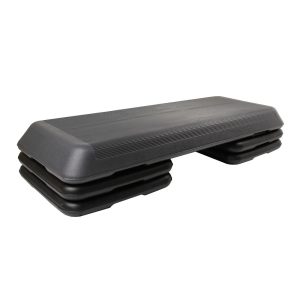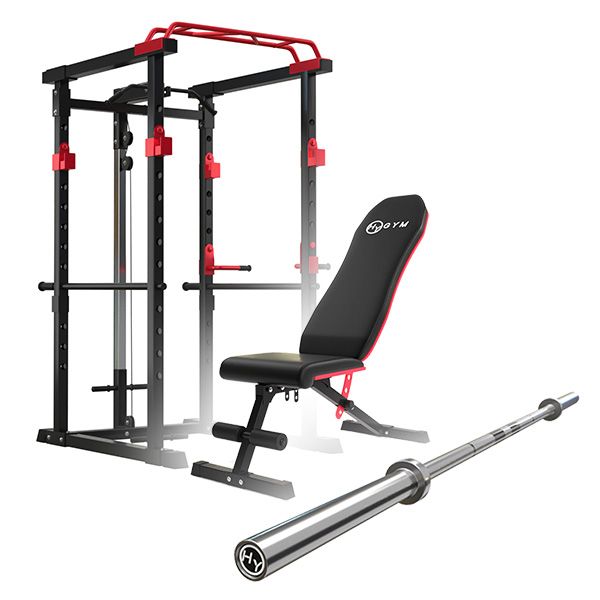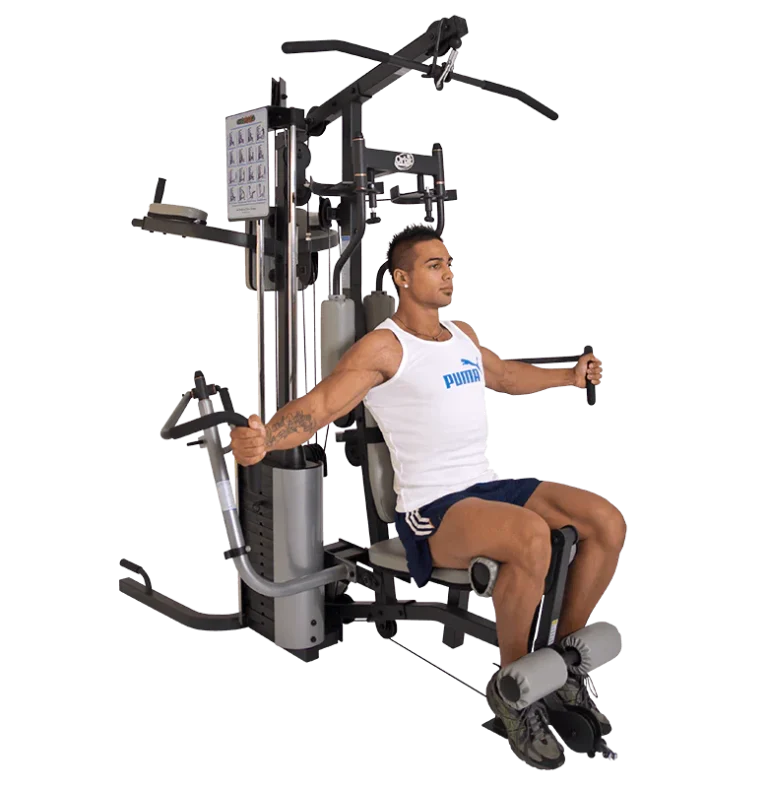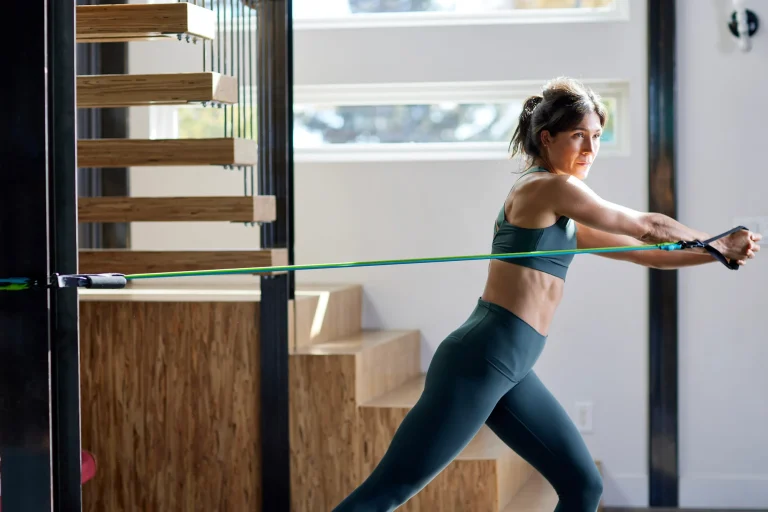Are you looking for a fun and effective way to enhance your fitness routine? Look no further than a step trainer! With its compact size and versatile design, a step trainer can provide you with a challenging and invigorating workout right in the comfort of your own home. Whether you’re a beginner or a seasoned fitness enthusiast, this article will explore the benefits of incorporating a step trainer into your fitness regimen. So, get ready to step up your game and unleash your inner fitness guru!
Table of Contents
ToggleBenefits of using a step trainer
Improves cardiovascular fitness
Using a step trainer is an excellent way to improve your cardiovascular fitness. The repetitive stepping motion engages your lower body muscles and gets your heart rate up, providing a great cardiovascular workout. Regular use of a step trainer can help strengthen your heart, increase stamina, and improve overall cardiovascular health.
Increases lower body strength
One of the major benefits of using a step trainer is the increase in lower body strength. With each step, you engage your leg muscles, including your quadriceps, hamstrings, calves, and glutes. Over time, this repetitive motion can help strengthen and tone these muscles, giving you stronger and more defined legs. Additionally, the resistance settings on many step trainers can be adjusted to provide an increased challenge, further building lower body strength.
Enhances coordination and balance
Step training requires coordination and balance, which makes it an excellent choice for improving these skills. As you step up and down on the platform, you need to maintain stability and control throughout the movement. This helps to improve your coordination between different muscle groups and enhances your overall balance. The more you practice step training, the better your coordination and balance will become.
Burns calories and aids in weight loss
If your goal is weight loss, a step trainer can be a valuable tool in your fitness routine. Stepping on a step trainer burns calories and helps create a calorie deficit, which is essential for weight loss. The number of calories burned will depend on factors such as your weight, duration of the workout, and intensity level. Incorporating regular step training sessions into your routine can contribute to steady and healthy weight loss.
Low impact workout option
For individuals with joint issues or those who prefer low impact workouts, a step trainer is an ideal choice. Unlike high impact exercises such as running or jumping, step training provides a low impact workout that is gentle on the joints. The platform absorbs the shock and reduces stress on the knees and ankles. This makes it a suitable option for people of all fitness levels, including those recovering from injuries or joint conditions.
Customizable intensity levels
One of the great features of a step trainer is the ability to customize the intensity levels of your workout. Many step trainers offer adjustable resistance settings or platforms that can be adjusted to different heights. This allows you to control the difficulty of your workout and tailor it to your individual fitness level. Whether you’re a beginner looking for a gentle workout or an advanced exerciser seeking a more intense session, a step trainer can accommodate your needs.
Different types of step trainers
When it comes to step trainers, there are several different types available on the market. Each type offers its own unique features and benefits. Let’s take a closer look at some of the most common types of step trainers:
Traditional step trainers
Traditional step trainers feature a large, flat platform that mimics the motion of climbing stairs. These are the most common and widely used type of step trainers. They often come with adjustable platforms and resistance settings, making them suitable for users of all fitness levels.
Mini steppers
Mini steppers are a compact and portable version of traditional step trainers. They consist of small, individual pedals that you step on to simulate stair climbing. They are lightweight and easy to store, making them a popular choice for home workouts or for those with limited space.
Air steppers
Air steppers rely on air pressure to create resistance. They feature a large air-filled cylinder or two separate pedals that you step on. As you press down, the air pressure increases, providing resistance and a more challenging workout. Air steppers are a great option for those looking for a low impact, yet intense cardio workout.
Twist steppers
Twist steppers are designed with a twisting motion in addition to the step motion. This twisting action engages your core muscles and provides a more comprehensive workout. Many twist steppers also include resistance bands or handles for upper body exercises, making them a versatile choice for a full-body workout.
Hydraulic steppers
Hydraulic steppers use hydraulic pistons to create resistance as you step. They often have adjustable resistance levels and are known for their smooth and quiet operation. Hydraulic steppers are a popular choice for those seeking a low impact workout with customizable resistance.
Belt-Resistant steppers
Belt-Resistant steppers use a belt mechanism to simulate the stepping motion. They are similar to traditional step trainers but offer a smoother and quieter operation. These steppers often have adjustable resistance levels and can be a great choice for those who prefer a more comfortable and seamless stepping experience.
Factors to consider when choosing a step trainer
With so many options available, it’s important to consider various factors when choosing a step trainer that suits your needs. Here are some key factors to consider before making a purchase:
Size and portability
Consider the size and portability of the step trainer, especially if you have limited space or plan on using it in different locations. Mini steppers or compact models may be a better choice for those with limited space, while larger traditional step trainers may be more suitable for a dedicated home gym.
Weight capacity and stability
Check the weight capacity of the step trainer to ensure it can support your weight. It’s also important to consider the stability and sturdiness of the trainer, especially if you tend to move or step quickly during workouts. Look for trainers with a wide base or non-slip feet to ensure stability while exercising.
Resistance settings and adjustability
Look for step trainers that offer adjustable resistance settings or platforms that can be adjusted to different heights. This will allow you to customize the intensity of your workouts. Consider your current fitness level and goals when choosing a step trainer with suitable resistance options.
Display features and tracking capabilities
Some step trainers come equipped with display features that show information such as time, distance, calories burned, and heart rate. These can be useful for tracking your progress and keeping you motivated. Consider the type of information you want to track and choose a step trainer that offers the desired display features.
Safety features
Safety should always be a priority when using fitness equipment. Look for step trainers that have safety features such as non-slip platforms, handrails, or locking mechanisms. These features can provide additional support and stability during your workouts.
Price range
Consider your budget when choosing a step trainer. Prices can vary depending on the brand, features, and quality of the equipment. Set a realistic budget and choose a step trainer that offers the desired features within your price range. Remember, investing in a quality step trainer can provide long-term benefits and durability.
Step trainer exercises for a full-body workout
While step trainers primarily target the lower body, there are several exercises you can incorporate to engage your entire body. Here are some step trainer exercises for a full-body workout:
Basic step-ups
Start with a basic step-up exercise to warm up and get familiar with the stepping motion. Stand facing the step trainer and step up onto the platform with one foot. Follow with the other foot. Step down one foot at a time and repeat. Focus on maintaining proper form and a steady pace.
Squat jumps
This exercise adds a plyometric element to your step training routine. Start with a basic step-up onto the platform. As you step up, perform a deep squat and then explosively jump off the platform, extending your legs and reaching your arms overhead. Land softly back onto the platform and repeat.
Lateral steps
Stand beside the step trainer with one foot on the platform and the other foot on the floor. Step up onto the platform with the foot that was on the floor, lifting the other foot off the ground. Step back down to the starting position and repeat on the other side. This exercise targets the outer thighs and glutes.
Knee raises
Stand facing the step trainer with your hands lightly touching the handrails for balance. Step up onto the platform with one foot and simultaneously lift the opposite knee toward your chest. Lower the foot back down and repeat on the other side. This exercise targets the core and hip flexors.
Kickbacks
Begin by standing facing the step trainer with your hands lightly touching the handrails. Step up onto the platform with one foot and extend the other leg behind you in a kicking motion. Lower the leg back down and repeat on the other side. This exercise targets the glutes and hamstrings.
Push-ups
Perform push-ups with your hands placed on the edge of the step trainer platform. Step back into a plank position, keeping your body straight. Bend your elbows and lower your chest toward the platform, then push back up to the starting position. This exercise targets the chest, shoulders, and triceps.
Plank variations
Use the step trainer to add variety to your plank exercises. Place your elbows or hands on the platform and step back into a plank position. Hold for a set amount of time or incorporate movements such as knee tucks or hip dips to increase the challenge.
Standing bicep curls
Hold a pair of dumbbells and stand facing the step trainer. Place one foot on the platform and keep the other foot on the ground. Perform bicep curls by bending your elbows and bringing the dumbbells toward your shoulders. Lower the dumbbells back down and repeat. This exercise targets the biceps and core stability.
Shoulder presses
Hold a pair of dumbbells at shoulder height, with your feet hip-width apart. Step up onto the platform with one foot, while simultaneously pressing the dumbbells overhead. Lower the dumbbells back down and repeat on the other side. This exercise targets the shoulders and upper body strength.
Tricep dips
Sit on the edge of the step trainer, facing away from the platform. Place your hands next to your hips, gripping the edge of the platform. Extend your legs out in front of you and lower your body down by bending your elbows. Press back up to the starting position and repeat. This exercise targets the triceps and shoulders.
Tips for using a step trainer effectively
To make the most out of your step trainer workouts, consider the following tips:
Warm-up and cool-down
Always start your step trainer session with a proper warm-up to prepare your muscles and increase blood flow. Perform dynamic stretches or light cardio exercises for a few minutes. After your workout, take the time to cool down and stretch to promote muscle recovery and flexibility.
Start with proper form
Focus on maintaining proper form throughout your step trainer exercises. Keep your back straight, engage your core, and avoid hunching over or arching your back. Pay attention to your foot placement on the platform and ensure your weight is evenly distributed.
Gradually increase intensity
If you’re new to step training or returning from a break, start with a lower intensity and gradually increase as your fitness improves. Push yourself, but listen to your body and avoid overexertion. Increase the resistance, speed, or duration of your workouts gradually over time.
Include variety in your workouts
To prevent boredom and challenge different muscle groups, vary your step trainer workouts. Incorporate different exercises, resistance levels, or interval training to keep your workouts engaging and effective. You can also combine step training with other forms of cardio or strength training for a well-rounded routine.
Monitor your heart rate
Consider using a heart rate monitor to track your heart rate during your step trainer workouts. This can help you gauge the intensity of your exercise and ensure you’re working within your target heart rate zone. Adjust the speed or resistance if necessary to reach your desired heart rate range.
Stay hydrated
Drink plenty of water before, during, and after your step trainer workouts to stay hydrated. Make sure to have a water bottle nearby and take regular water breaks during your session. Sweating during exercise increases fluid loss, so it’s important to replenish your body with fluids.
Listen to your body
Pay attention to how your body feels during and after your step trainer workouts. If you experience any pain or discomfort, modify or stop the exercise. It’s important to listen to your body’s cues and avoid pushing through pain, as this can lead to injuries. If in doubt, consult with a healthcare professional.
Common mistakes to avoid while using a step trainer
To ensure a safe and effective step trainer workout, avoid these common mistakes:
Using improper form
Maintaining proper form is crucial to avoid injuries and get the most out of your step training. Avoid slouching or leaning too far forward, as this can strain your back and knees. Keep your chest lifted, shoulders down, and engage your core. Follow proper foot placement on the platform and pay attention to your body alignment.
Excessive reliance on handrails
While handrails can provide support and stability, excessive reliance on them can detract from the effectiveness of the exercise. Over-gripping the handrails can reduce the engagement of your legs and core muscles. Gradually reduce your dependence on handrails as your balance and stability improve.
Skipping warm-up and cool-down
Skipping warm-up and cool-down exercises increases the risk of injury and prevents your body from properly preparing or recovering from exercise. Dedicate time to warm-up your muscles and gradually increase the intensity. Afterward, allow time for a cool-down with gentle stretches to relax your muscles and prevent stiffness.
Overtraining without rest days
While it’s important to be consistent with your exercise routine, overtraining without adequate rest and recovery can lead to burnout and injuries. Give your body time to recover with rest days or light active recovery exercises. This allows your muscles to repair and strengthen, contributing to long-term progress.
Ignoring warning signs of injury
Pay attention to any warning signs of injury, such as sharp pain, swelling, or persistent discomfort. Pushing through pain can lead to further damage and hinder your progress. If you experience any symptoms of injury, stop exercising and seek appropriate medical advice.
Safety precautions to follow
To ensure your safety while using a step trainer, follow these precautions:
Consult with a healthcare professional
If you have any pre-existing medical conditions, injuries, or concerns, consult with a healthcare professional before starting a step trainer workout routine. They can provide personalized recommendations and guidance based on your individual needs.
Start with a low resistance level
Beginners should start with a low resistance level and gradually increase as their fitness improves. This allows your body to adjust to the new exercise and reduces the risk of overexertion or strain. Listen to your body and increase the resistance level when you feel comfortable and ready.
Secure the step trainer properly
Make sure the step trainer is properly assembled and secure before using it. Follow the manufacturer’s instructions for assembly and ensure all parts are tightened and stable. Use on a flat and even surface to maintain stability during your workouts.
Avoid distractions during workouts
Focus on your step trainer workout and avoid distractions that might compromise your safety. Remove any objects or obstacles around the trainer to prevent trips or falls. Keep your attention on maintaining proper form and engaging the correct muscles.
Use appropriate footwear
Wear proper athletic footwear that provides support and traction while using the step trainer. Choose shoes with good arch support and cushioning to protect your feet and joints. Avoid using the trainer barefoot or in socks to prevent slipping.
Maintain good posture
Maintain correct posture throughout your step trainer exercises. Keep your shoulders back, chest lifted, and engage your core muscles. Avoid leaning on the handrails and distribute your weight evenly between both feet.
Listen to your body
Pay attention to how your body feels during and after your step trainer workouts. If you experience pain, dizziness, or shortness of breath, stop exercising and rest. If symptoms persist, seek medical attention. It’s important to listen to your body’s signals and prioritize your safety and well-being.
How to incorporate a step trainer into your fitness routine
To effectively incorporate a step trainer into your fitness routine, consider the following tips:
Set specific goals
Set clear goals that you want to achieve with your step trainer workouts. Whether it’s weight loss, improved cardiovascular fitness, or toning specific muscle groups, having specific goals can help you stay motivated and track your progress.
Create a workout schedule
Plan your step trainer workouts in advance by creating a workout schedule. Allocate specific days and times for your workouts and stick to your schedule as much as possible. This helps create consistency and ensures you prioritize your fitness goals.
Combine step trainer exercises with other workouts
Incorporate your step trainer exercises with other forms of exercise to create a well-rounded fitness routine. Combine step training with strength training exercises, cardio workouts, or flexibility exercises to target different muscle groups and provide variety.
Track your progress
Monitor and track your progress to stay motivated and gauge your fitness improvements. Keep a record of your workouts, including the duration, intensity, and any changes in resistance or difficulty levels. Take measurements or progress photos to visually track your body’s transformation.
Include rest and recovery days
Give your body adequate rest and recovery by incorporating regular rest days into your fitness routine. Rest days promote muscle repair and growth, preventing overtraining and burnout. Use these days to engage in light activities such as stretching, yoga, or leisurely walks.
Adjust intensity levels
Regularly assess your progress and adjust the intensity levels of your step trainer workouts. Gradually increase the resistance or duration of your exercises as your fitness improves. Challenge yourself to prevent plateauing and to continue making progress toward your goals.
Stay motivated
Maintaining motivation is key to a successful fitness routine. Find ways to stay motivated, such as setting rewards for achieving milestones, listening to energizing music during workouts, or working out with a friend or a fitness group. Celebrate your achievements and keep your focus on the positive changes you’re making in your health and well-being.
Comparison between a step trainer and other cardio exercises
While a step trainer offers numerous benefits, it’s helpful to compare it to other forms of cardio exercises to find the best fit for your fitness goals and preferences. Let’s take a look at how a step trainer compares to other popular cardio exercises:
Treadmill
A treadmill provides a similar motion to walking or running, making it a great option for aerobic exercise. It allows for varying speeds and incline levels to simulate outdoor terrain. While a treadmill offers more impact on joints compared to a step trainer, it provides a higher calorie burn and can be suitable for those who prefer a more running-focused workout.
Elliptical machine
Elliptical machines provide a low impact, full-body workout by simulating the motion of walking, running, and stair climbing. They offer adjustable resistance levels and handrails for stability. Compared to a step trainer, elliptical machines engage both the upper and lower body muscles simultaneously, making them a comprehensive cardiovascular exercise option.
Stationary bike
Stationary bikes offer a seated and pedaling motion that targets the lower body muscles. They are low impact and provide options for both high intensity and endurance workouts. While stationary bikes primarily engage the lower body, they offer a comfortable and joint-friendly exercise option, particularly for individuals with knee or hip issues.
Stair climber
Stair climbers simulate the motion of climbing stairs and provide a high intensity cardiovascular workout. They engage the lower body muscles, similar to a step trainer, but with a heavier focus on the vertical stepping motion. Stair climbers offer adjustable resistance levels and height options, allowing for customization based on fitness levels.
The choice between a step trainer and other cardio exercises ultimately depends on your fitness goals, preferences, and any existing conditions or limitations. Consider factors such as impact on joints, muscle engagement, calorie burn, and overall enjoyment to select the cardio exercise that aligns with your needs.
Potential drawbacks of using a step trainer
While step trainers offer numerous benefits, there are some potential drawbacks to consider:
Limited upper body workout
Step trainers primarily engage the lower body muscles, and while some exercises incorporate the upper body, they may not provide as comprehensive of an upper body workout as other forms of exercise. To ensure a well-rounded fitness routine, it’s important to supplement step trainer workouts with strength training exercises that target the upper body.
Risk of repetitive strain injury
Engaging in repetitive stepping motions for prolonged periods can put stress on certain joints and muscles, potentially increasing the risk of repetitive strain injury. To minimize this risk, ensure you have proper form, listen to your body’s signals, and incorporate rest days or vary your workouts to avoid overuse.
May not be suitable for individuals with certain conditions
Some individuals with pre-existing conditions or injuries, such as knee problems or arthritis, may find the repetitive stepping motion of a step trainer uncomfortable or exacerbating their symptoms. It’s important to consult with a healthcare professional before starting a step trainer workout routine if you have any concerns or conditions that may be affected.
Can be monotonous over time
Like any exercise routine, step trainer workouts can become monotonous over time if you don’t vary your exercises or intensity levels. To keep your workouts interesting and maintain your motivation, incorporate different exercises, challenge yourself with new routines, or use music or workout videos to stay engaged.
By being aware of these potential drawbacks and taking the necessary precautions, you can safely and effectively incorporate a step trainer into your fitness routine and enjoy the numerous benefits it provides. Remember to listen to your body, prioritize your safety, and make the necessary adjustments to meet your individual needs and goals. Start stepping and enjoy the journey to better health and fitness!








